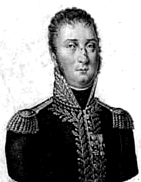General Baptiste-Pierre-François Jean-Gaspard Bisson

Born: February 16, 1767
Place of Birth: Montpellier, Hérault, France
Died: July 26, 1811
Cause of Death: Apoplexy
Place of Death: Mantua, Italy
Arc de Triomphe: BISSON on the east pillar
Pronunciation:
One of the largest men of the time, Baptiste-Pierre-François Jean-Gaspard Bisson's first military experience came at age five when he was adopted as the child of infantry regiment of Dauphin. Nine years later at at age 14 he enlisted in the same regiment. With the arrival of the Revolution in 1789, Bisson joined the Parisian National Guard in July but then quit in October to join the National Guard of Dunkirk. As an exceptionally tall man, Bisson was elected a capitaine of grenadiers in the 2nd Battalion of Volunteers of Nord two years later. Bisson went on to serve in the Army of the North in 1792 and then the Army of the Ardennes in 1793. In 1794 he distinguished himself at Câtelet, received a promotion to chef de bataillon, and joined the Army of the Sambre and Meuse when the army was reorganized. Only a few months later in September of 1794 Bisson was promoted to chef de brigade by the representatives of the people accompanying the army. Known as a lover of good food and wine, he would order his men to salute his favorite vineyard, the Clos Vougeot, when they passed by.1
In 1797 Bisson was serving in Bernadotte's division and he was sent with Bernadotte to the Army of Italy. After remaining there for a few years, in 1800 he joined the Army of the Reserve and fought at the Battle of Marengo where he distinguished himself. Less than a month after Marengo, Bisson was promoted to général de brigade of the 2nd Brigade of the 2nd Division of the Army of Italy. That December he served with Boudet at the crossing of the Mincio and at Monzembano. Sometime after Napoleon took power he granted Bisson extra rations to satisfy his immense appetite.
During the years of peace that followed, General Bisson returned to France where he was employed in the 6th military division. In 1803 he took command of a brigade of the 1st Infantry Division at the camp of Saint-Omer. Two years later Bisson was promoted to général de division and he took command of the 1st Infantry Division at the camp of Bruges. When war broke out later that year, his division served as part of Marshal Davout's I Corps on the campaign. That November Bisson fought at Lamach during the crossing of the Traun River where he was badly wounded. After the conclusion of the campaign, he was created a Grand Officer of the Legion of Honor and a Knight of the Iron Crown of Italy.
In 1806 General Bisson served in a military division until that October when he rejoined the army as governor general of Brunswick. In February of 1807 he replaced the wounded General Gardanne in command of the 2nd Division of Marshal Ney's VI Corps. During the campaigns that followed, Bisson fought at the Battle of Friedland that June.
Named a Count of the Empire in 1808, Bisson then went on to Spain with the same division. After serving as governor of Navarre for a period of time, he was next sent to the Army of Italy where he took command of a French column in the Tyrol. Forced to surrender by the Austrians in April, Bisson remained unemployed until December of 1809 when he received command of the 1st Division of XI Corps in Illyria. By this time Bisson had grown quite obese despite his height and he was not fit enough for an active campaign. In 1810 he took a command at Verona where he remained until his early death in 1811. The famous French food critic Brillat-Savarin wrote that Bisson could drink eight bottles of wine with his dinner and still make jokes and give orders as if he only had a single drink.
Notes
Bibliography
Updated February 2018
© Nathan D. Jensen